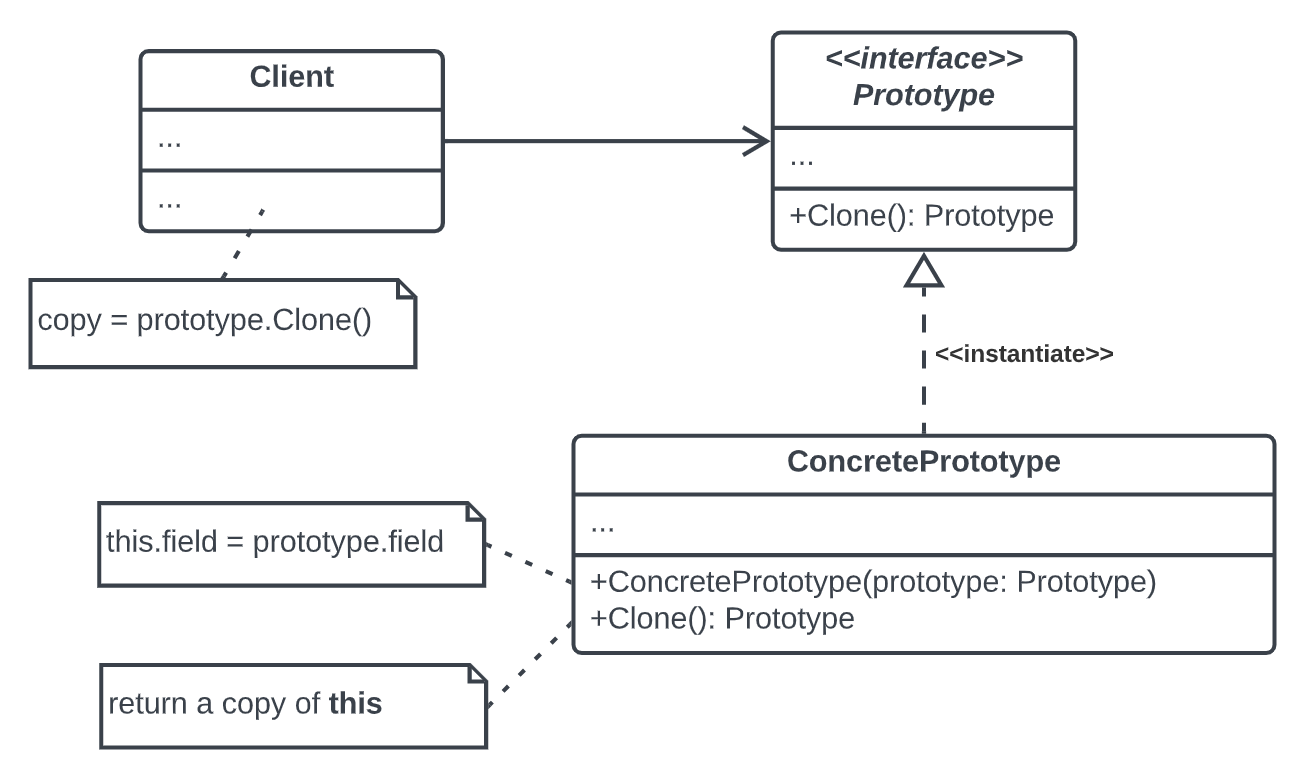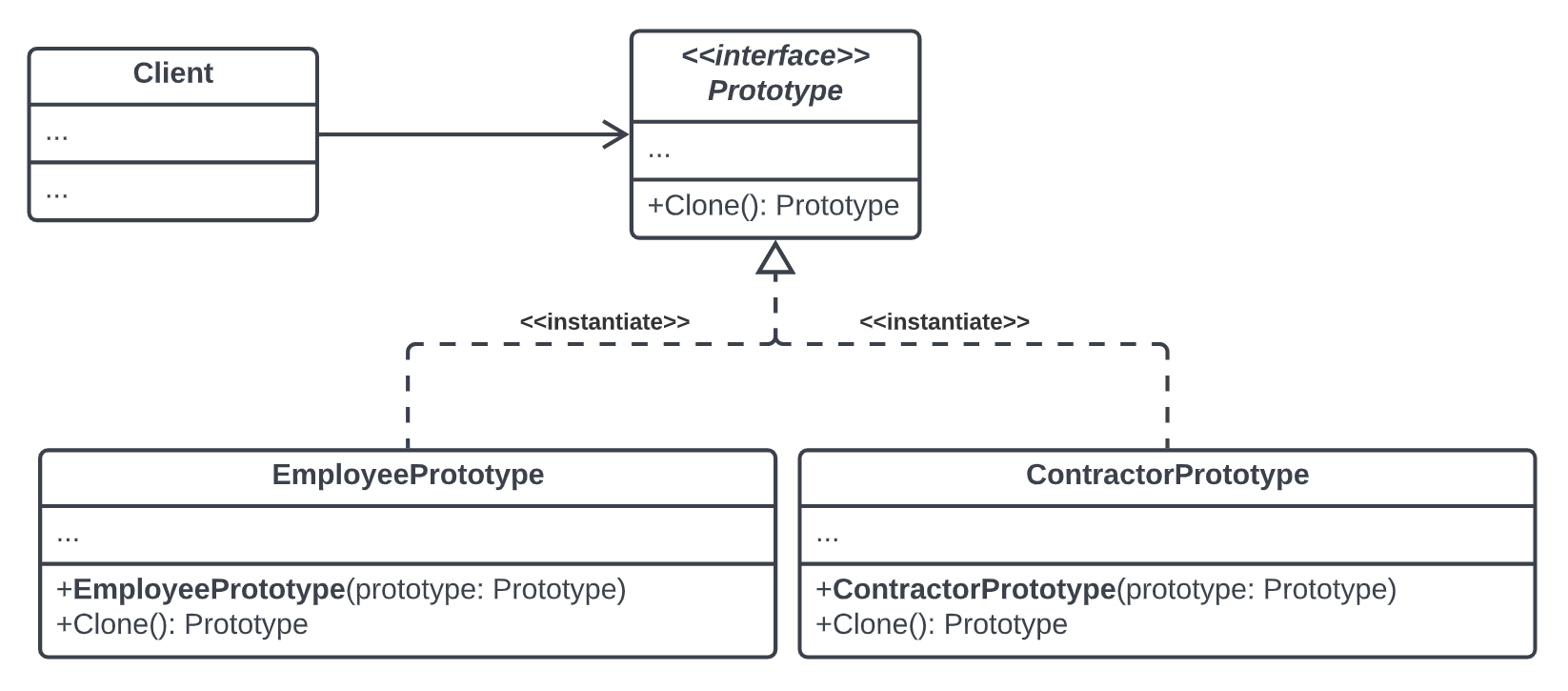Prototype is a creational design pattern that lets us duplicate existing objects without having our code depend on their classes. For example, this pattern could be used to create multiple instances of the same object with unique attribute values such as color or size. Instead of creating a new class for each variation of an object, a prototype with the basic property values can be cloned and modified for each new instance. This approach improves maintainability and reduces redundancy in the codebase. However, it may not be suitable for complex object hierarchies, as managing prototype objects can become cumbersome.

How does the Prototype Design Pattern work?
So, the main idea behind this pattern is to hide the complexity of object creation and provide a way to create new objects by copying existing ones.
This can be accomplished by delegating the cloning process to the actual objects being cloned. The pattern declares a common interface for all cloneable objects. This interface allows us to clone an object without coupling our code to the object’s class. Typically, such an interface contains just a single Clone() method.
The Clone() method is implemented similarly in all classes. The method creates an object of the current class and transfers all of the old object’s field values to the new one. Even the private fields can be copied because most programming languages allow objects to access the private fields of other objects of the same class.
The UML diagram for the Prototype Creational Design Pattern

The Prototype interface declares the cloning methods. In most cases, there is only one Clone() method.
The cloning method is implemented by the Concrete Prototype class. This method may handle several edge circumstances of the cloning process such as cloning linked objects, untangling recursive dependencies, and so on, in addition to copying the original object’s contents to the clone.
The client can produce a copy of any object that implements the prototype interface.
An example of Prototype Design Pattern implementation in C#
For a sample of how this Design Pattern can be put into practice, we are going to create an extension for our old friend, the furniture shop application introduced in the post related to Abstract Factory. The extension that we’re talking about will manage the different types of employees in our furniture shop. Because we need to enter a lot of data for an employee (in a real-world scenario), it will be more convenient to use a prefilled profile (a prototype) and to change only what is specific.

As shown on the diagram, for simplicity, we’ll consider just two profiles: Employee (Prototype), and Contractor (Prototype). The properties are omitted for brevity, but the C# 11 source code is available on GitHub. In our example, the Client is actually the main function of the application.
Advantages of the Prototype Design Pattern
- Object creation without coupling to specific classes: The Prototype Design Pattern allows you to create new objects by cloning existing ones without being bound to the specific classes of the objects being cloned. This promotes decoupling between the client code and the concrete classes, making it easier to introduce new types of objects without modifying the client code.
- Reduces the need for subclassing: The Prototype pattern can be a more flexible alternative to subclassing in cases where we would usually derive subclasses to create variations of objects. We can clone existing objects and modify them instead of deriving subclasses. This approach simplifies the object creation process and reduces the complexity of class hierarchies.
- Efficient object creation: Creating new objects through cloning can be more efficient than creating them from scratch. Cloning avoids the overhead of initializing objects and setting their initial state. Instead, you can clone a pre-configured prototype and modify only the necessary attributes or properties.
- Customizable object creation: The Prototype pattern allows us to create new objects with customized attributes or properties. You can clone a prototype and then modify the clone to meet specific requirements. This flexibility is especially useful when creating complex objects with many configurable parameters.
- Simplifies object initialization: Object initialization can be complex, especially when dealing with dependencies and complex construction logic. The Prototype pattern simplifies object initialization by allowing us to clone a fully initialized object and then modify it as needed. This approach can help avoid complex initialization code and improve the overall readability and maintainability of the code.
- Supports dynamic runtime changes: Prototypes can be modified at runtime, allowing us to change the behavior or configuration of objects on the fly. Instead of creating new objects, we can clone existing ones and apply runtime modifications to adapt to different scenarios or user preferences.
- Supports creating object hierarchies: Prototypes can be used to create object hierarchies by allowing prototypes to reference other prototypes. This enables the creation of complex object structures and relationships without the need to explicitly define them in code.
Disadvantages of the Prototype Design Pattern
While the Prototype Design Pattern offers several advantages, there are also some potential disadvantages to consider:
- Complexity of managing prototypes: The Prototype pattern introduces the need for managing a registry or a collection of prototypes. This registry can become complex to maintain, especially in applications with a large number of different prototypes. It requires careful management to ensure the correct registration and retrieval of prototypes.
- Deep copying challenges: To ensure the integrity of the cloned objects, the Prototype pattern often requires deep copying of the attributes and internal state. This process can become complex and error-prone, especially when dealing with nested objects or complex data structures. Implementing proper deep copying logic can be a non-trivial task.
- Cloning limitations: Some objects may not be easily cloneable or may not support the cloning process at all. In such cases, using the Prototype pattern becomes challenging or even impossible. Objects that contain non-serializable or non-copyable resources, such as network connections or file handles, may not be suitable for cloning.
- Impact on performance and memory usage: While cloning objects can be more efficient than creating them from scratch, the Prototype pattern can introduce additional memory usage. Cloning objects, especially deep copies, can consume more memory compared to simply instantiating new objects. Additionally, maintaining a registry of prototypes can also consume memory.
- Potential confusion with object references: Cloning objects may lead to unexpected behavior if the objects contain references to other objects. Changes made to one object may unintentionally affect the cloned object or other objects it references. Proper care must be taken to ensure that object references are correctly handled during the cloning process.
- Difficulty in applying the pattern to existing systems: Integrating the Prototype pattern into an existing codebase or system can be challenging, especially if the codebase was not designed with prototype-based object creation in mind. Retrofitting the pattern may require refactoring existing code and making significant changes to the object creation logic.
- Limited compile-time type checking: Since the Prototype pattern relies on cloning existing objects, compile-time type checking may be limited. The types of the cloned objects may not be known until runtime, which can potentially lead to errors if the cloned objects are not compatible with the client code’s expectations.
It’s important to carefully consider these disadvantages in relation to your specific use case before deciding to employ the Prototype Design Pattern.
When to use the Prototype Design Pattern and what problems does it solve?
The Prototype Design Pattern is useful in various scenarios where you want to create new objects by cloning existing ones. Here are some situations where you can consider using the Prototype Design Pattern:
- When object creation is expensive: If creating objects from scratch is a time-consuming or resource-intensive process, the Prototype pattern can be beneficial. Cloning existing objects is typically faster and more efficient than creating new objects and initializing them.
- When we want to avoid tightly coupling the client code to specific classes: The Prototype pattern decouples the client code from the concrete classes of the objects being cloned. This allows us to create new objects without having detailed knowledge of their specific classes, promoting flexibility and extensibility in our code.
- When we want to reduce the number of subclasses: Instead of creating subclasses to represent variations of objects, the Prototype pattern allows us to clone existing objects and modify their attributes or properties. This can help avoid creating a large number of subclasses and simplify the class hierarchy.
- When we need to create objects with different configurations: The Prototype pattern enables us to create objects with different configurations by cloning a prototype and modifying the clone as needed. This can be useful when creating complex objects with multiple configurable parameters.
- When we want to customize object creation at runtime: Prototypes can be modified at runtime, allowing us to adapt the behavior or configuration of objects dynamically. This flexibility is beneficial when we need to adjust object properties based on changing conditions or user preferences.
- When we want to create object hierarchies dynamically: The Prototype pattern supports the creation of object hierarchies by allowing prototypes to reference other prototypes. This enables the dynamic construction of complex object structures and relationships.
- When we want to simplify object initialization: The Prototype pattern simplifies object initialization by cloning a fully initialized object and modifying it as needed. This can help avoid complex initialization logic and improve the readability and maintainability of our code.
Conclusion
The Prototype Design Pattern is a creational pattern that provides a flexible and efficient way to create new objects by cloning existing ones. It promotes code reusability, reduces coupling, and simplifies object creation and customization. However, it’s important to carefully consider these disadvantages in relation to our specific use case before deciding to employ the Prototype Design Pattern.
It’s worth noting that the Prototype Design Pattern is most effective when the cloning process produces deep copies of objects, ensuring that all attributes and internal state are properly replicated. Additionally, the pattern is particularly valuable in languages that support native cloning or provide easy ways to implement deep copy functionality.
The C# 11 source code for the sample can be found on GitHub.








